Transforming systems, transforming ourselves
At UNDP Innovation we are on a journey to shift our approach to innovation to help tackle complex development challenges. In short, we are moving away from single point solutions, and instead we are trying to figure out how to develop interventions that are more coherent with the nature of complex systemic challenges. On this blog, I’m sharing (in “real time”) my reflections, insights and ramblings emerging from this exciting and immensely difficult journey. You can find the past blogs in this series here.
26–30 October: Internal organizational change and external systems transformation
UNDP Innovation’s pivot towards focusing on transforming complex systems presents a dual challenge. At one level we are trying to help transform real-world systems in developing countries. We collaborate with great colleagues in country offices such as Bolivia, Burundi and Vietnam (for a full overview see here) to help transform cities, improve lives in border communities and ensure local private sector resilience in the wake of covid. We call this external transformation.
At another level, we are also trying to transform how UNDP itself works (see here for more on how we are trying to change ourselves). For instance, how we can move beyond short-term solutions-focused and projectized interventions towards longer-term, problem-driven portfolios. We call this internal transformation.
It may at first seem overly ambitious to tackle both challenges simultaneously and people may justifiably ask if we aren’t putting the cart before the horse (or at least alongside it). Would it not make more sense to take on these challenges sequentially? Especially, if you are a relatively small team that works with finite resources within a large global organization.
However, internal organizational change and external systems transformation are deeply entwined processes. For instance, we know that we need to change how we work if we are to help transform complex systems in the real world. Yet, we don’t really know how to change or build the momentum for this change until we’ve begun to “do”, fail and learn from actually engaging in the real world.
To get started, we therefore have to take on both challenges in tandem: trying to transform the world while we transform ourselves. This is difficult! In the beginning, it has presented a lot of challenges and I have often felt like we are trying to run before we can walk.
Yet, now that we’re underway, I notice virtuous feedback loops. First, real-world experiences enable us to understand how UNDP needs to change internally to remain relevant and useful for governments and communities. In Angola, we are working with UNDP colleagues on what is usually called informal markets. UNDPs (and most others’) knee-jerk reaction to this type of issue is to see it as a problem (a bug in the system rather than a feature of it) and to respond with efforts focused on formalization — i.e. regulation and enforcement aimed at getting market vendors to comply with formal rules (for notable exceptions see the Informal Urbanism Research Hub). The word we use to characterize these types of markets (informal) nudges us down this route, because it leads us to understand the issue of interest (markets) in opposition to something else (the formal) rather than as a thing in and of itself. However, if we try to actually understand these types of markets we learn (unsurprisingly!) that they are so much other than unregulated spaces. For instance, they are very inclusive (accessible to most — if not all — parts of society) and they operate based on a type of self-governance that is rooted in social networks based on trust, reputation and shared needs. If UNDP wants to be a useful partner in improving these types of markets (whatever we call them), then we need to change the way we understand and talk about them and the toolboxes we use to design and implement interventions (see here for more on how internal donor practices and policies, such as providing only short-term, restricted grants, can make it difficult for partners on the ground to achieve change on a deeper level). More fundamentally, we also need to take a hard look at ourselves and consider what types of challenges we are best placed to take on and what we can credibly do.
Second, engaging in the world can also directly help us build capabilities, credibility, and momentum for internal change. This, in turn, positions us to better contribute to external transformation. For instance, based on the work of our UNDP colleagues in Vietnam we have learned more about the tools and capabilities that are useful when we want to engage a broader range of UN colleagues in a transformation initiative. We are now using this knowledge to help build awareness and support for internal transformation in UNDP (in fact this blog is part of the effort), which we can then leverage in our efforts towards external systems transformation. The visual below illustrates this virtuous relationship between internal and external change.
This way of working with systems transformation is fun and rewarding, but it is not easy, and it requires a high tolerance for emergence and ambiguity. It also relies on strong commitment to continuous learning, reflection, and adaptation (which is something I will talk about in one of the next blog posts).
We are far from the only organization grappling with how to work simultaneously with internal and external transformation, so please don’t hesitate to reach out if you’d like to talk, compare notes or vent
This work has been made possible with the generous support from Denmark.
